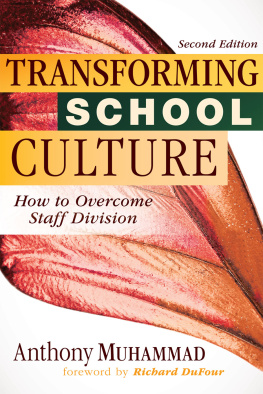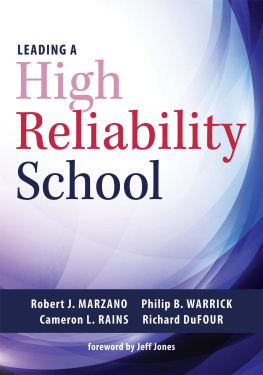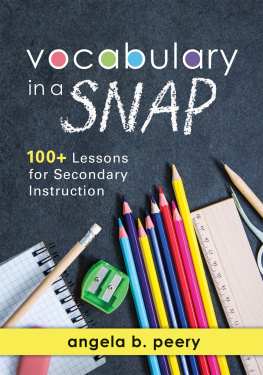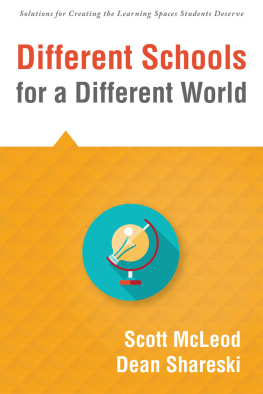


Copyright 2013 by Corwin
All rights reserved. When forms and sample documents are included, their use is authorized only by educators, local school sites, and/or noncommercial or nonprofit entities that have purchased the book. Except for that usage, no part of this book may be reproduced or utilized in any form or by any means, electronic or mechanical, including photocopying, recording, or by any information storage and retrieval system, without permission in writing from the publisher.
All trade names and trademarks recited, referenced, or reflected herein are the property of their respective owners who retain all rights thereto.
Printed in the United States of America.
Library of Congress Cataloging-in-Publication Data
Glaze, Avis.
High school graduation : K12 strategies that work / Avis Glaze, Ruth Mattingly, Rob Andrews.
pages ; cm
Includes bibliographical references and index.
ISBN 978-1-4522-1764-2 (pbk.)
1. School improvement programsOntario. 2. EducationOntario. 3. EducationAims and objectivesOntario. 4. Educational changeOntario. 5. High school graduatesOntario. I. Title.
LB2822.84.C2G53 2013
371.20709713dc23 2013005354
This book is printed on acid-free paper.
13 14 15 16 17 10 9 8 7 6 5 4 3 2 1

FOR INFORMATION:
Corwin
A SAGE Company
2455 Teller Road
Thousand Oaks, California 91320
(800) 233-9936
www.corwin.com
SAGE Publications Ltd.
1 Olivers Yard
55 City Road
London EC1Y 1SP
United Kingdom
SAGE Publications India Pvt. Ltd.
B 1/I 1 Mohan Cooperative Industrial Area
Mathura Road, New Delhi 110 044
India
SAGE Publications Asia-Pacific Pte. Ltd.
3 Church Street
#10-04 Samsung Hub
Singapore 049483
Acquisitions Editor: Arnis Burvikovs
Associate Editor: Desire A. Bartlett
Editorial Assistant: Mayan White
Permissions Editor: Jennifer Barron
Project Editor: Veronica Stapleton Hooper
Copy Editor: Matthew Connor Sullivan
Typesetter: C&M Digitals (P) Ltd.
Proofreader: Wendy Jo Dymond
Indexer: Molly Hall
Cover Designer: Michael Dubowe
Lists of Tables, Figures, and Appendices
Tables
Figures
Appendices
Preface
E ducators today are strategically placed to realize both excellence and equity in outcomes for studentsto raise the bar for all students and to close the achievement gaps. Variations in learning should no longer be attributed to background factors. Indeed, schools must remove barriers, empower students, and create the conditions necessary to ensure success for all.
This call to action is not an abstract theory of what could be, but rather an approach that educators are already taking in their districts, schools, and classroomsan approach that is already producing significant results. Educators are already convinced that they cannot give up now or show signs of disenchantment or discouragement. They are aware of their role in building a civil society, focusing on results, and advocating for students from diverse groups and those who live in poverty. In other words, educators are fully aware that the focus of education in the next few years has to be on removing the barriers that prevent an improvement in graduation rates. This mission is very important to the students from groups that have a history of failure or of dropping out of school. The need to build alliances and coalitions to support learning and to ensure that schools serve the needs of all students will take center stage. Politicians and parents alike will continue to demand that schools use the strategies at their disposal to raise the bar for all students and close achievement gaps for those who have not been successful in the past.
The litmus test or, indeed, the question we must ask ourselves is this: Can we afford to replicate the status quo? Under our watch, can there be throwaway kids? Will our society remain competitive in the global arena if a significant number of students cannot read, write, or do mathematics? Can we accept the fact that a large number of students will not graduate from high school? Can we, as educators, tolerate the waste of human potential if some students leave our schools without the education they deserve?
There is a cacophony of voices demanding improvement in the number of students who graduate from schools. There are persuasive arguments for a focus on the moral, economic, social justice, and human rights imperatives of schooling. Educators are taking this clarion call very seriously in their efforts to live up to the promise of making education a driving force for societal improvement and global competitiveness. Improving graduation rates will depend on educators and policy makers evaluating the effectiveness of the strategies that they are currently using from kindergarten to Grade 12, and revisiting the criteria for assessing the effectiveness of learning environments. It will require deep commitment to action and to monitoring what effect the implementation of their strategies is having for the success of our students. Student success, in terms of graduation, is not only dependent on the quality of instruction and educational experiences in high schools; it is also dependent on the strong foundation of knowledge, skills, and attitudes that is laid. It is also dependent on the establishment of high expectations for the success of all students beginning in the early years of a childs education.
The most important role of schools today is to ensure academic engagement and achievement from kindergarten to Grade 12. Our schools are uniquely positioned to equip our young people with the skills they require to be successful, contributing adults in our society. This challenge, however, is constant throughout the full breadth of the childs educational journey; specific interventions must be in place at all stages and transition points along the continuum. It is critical that educators recognize that improved graduation rates are dependent on improving teaching and learning throughout students journey from kindergarten to the end of high school. Waiting until high school to challenge and engage students or to implement intervention strategies is too late. Success is dependent on a whole-system approach at the district, school, and classroom levels, across the grades, beginning with strategies that are implemented at the first indication that students are not performing according to the established standards and criteria. These strategies must be focused and intentional with specific, appropriate, and targeted supports for students who are not succeeding. A strong safety net must be in place to give students more chances to achieve graduation. In the study Unlocking Potential for Learning (Campbell, Fullan, & Glaze, 2006), it was clearly shown that sustained improvement in student achievement depends on schools, districts, and provinces adopting an aligned approach that builds the capacity of teachers, school leaders, boards, district leaders, parents, and community allies. High SchoolGraduation: K12 Strategies That Work provides a comprehensive approach to school and district improvement using proven strategies to enhance student achievement and increase graduation rates.
Next page















